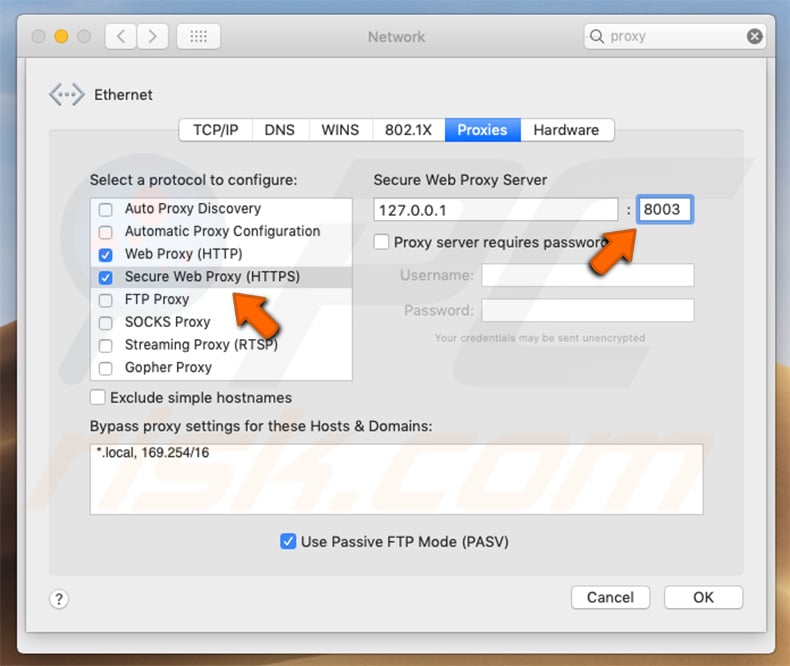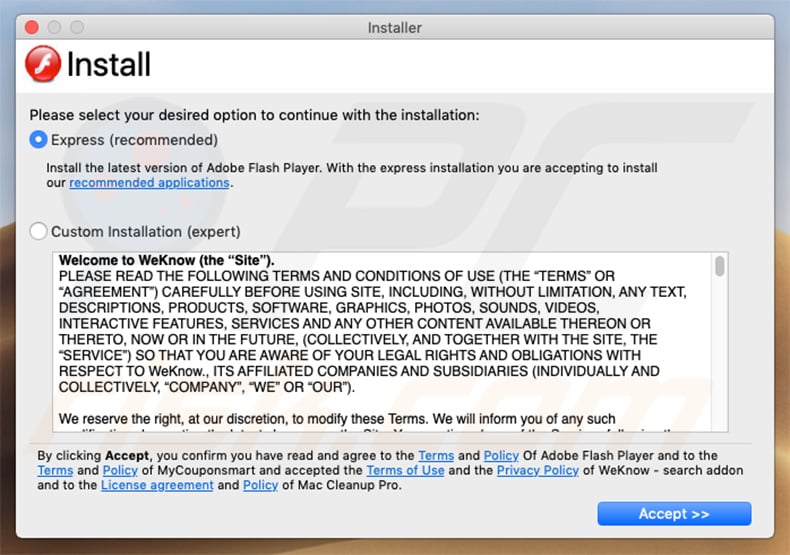Get free scan and check if your device is infected.
Remove it nowTo use full-featured product, you have to purchase a license for Combo Cleaner. Seven days free trial available. Combo Cleaner is owned and operated by RCS LT, the parent company of PCRisk.com.
What is "Proxy Virus"?
Proxy Virus (also known as MITM Proxy Virus) is a type of browser-hijacking program that has recently become popular. In order to spread this infection, cyber criminals often use various adware-type applications. In most cases, these infiltrate computers without users' permission.
Adware is also likely to deliver intrusive advertisements and record information relating to browsing activity.

Proxy Virus overview
The initial adware installation process seems normal. After installation, however, users are presented with a deceptive pop-up message encouraging them to update the Safari web browser. After clicking "OK", users are presented with another pop-up that asks users to enter account credentials.
In this way, users might inadvertently grant adware permission to control the Safari browser. Additionally, rogue installers deploy a 'bash script' designed to connect to a remote server and download a .zip archive. The archive is then extracted and a .plist file contained within it is copied to the LaunchDaemons directory.
The .plist file contains a reference to another file called "Titanium.Web.Proxy.Examples.Basic.Standard". Two additional scripts ("change_proxy.sh" and "trush_cert.sh") are executed after the next reboot. The "change_proxy.sh" script is designed to change the system proxy settings, thereby making it use HTTP/S proxy at "localhost:8003".
The "trush_cert.sh" script is designed to install a trusted SSL certificate into the keychain. Cyber criminals responsible for this infection use Titanium Web Proxy - an open-source asynchronous HTTP(S) proxy writen in C Sharp (C#). Titanium Web Proxy it is a cross-platform proxy, meaning that it can run on various operating systems, including MacOS.
The purpose of this infection is to hijack search engines. Cyber criminals use it to modify Internet search results. Using a proxy to achieve this is rather unusual, since cyber criminals typically employ fake search engines. They use various browser-hijacking applications to modify settings (e.g., new tab URL, default search engine, homepage) by assigning them to certain URLs.
Promoted websites often seem normal and their design is usually similar to Bing, Yahoo, Google, and other legitimate search engines. Yet, fake search engines can generate results that lead to malicious websites. Moreover, noticing that such browser settings have been modified is simple because users continually encounter redirects to dubious sites.
Using tools such as Proxy Virus is more difficult for these criminals, and yet also more reliable from their point of view. Cyber criminals also deliver fake search results by modifying the content of legitimate search engines.
For instance, if a user attempts to search using the Google search engine, the entire website (URL, header, footer, etc.) is genuine, however, the infection modifies the result section. In this way, users are fed with fake results even though they search using legitimate engines.
Ultimately, this behavior can lead to further high risk infections - users might inadvertently visit malicious websites. Additionally, cyber criminals use such tactics to increase the traffic of certain websites, which allows them to generate revenue through advertising.
The presence of Proxy Virus significantly diminishes the browsing experience and can lead to further computer infections. As mentioned above, adware-type applications are designed to deliver advertisements (e.g., coupons, banners, pop-ups, etc.). These ads might also redirect to malicious websites and even run scripts designed to download/install other unwanted apps.
Therefore, clicking them can also lead to installation of infectious apps. Additionally, ads are delivered using tools that enable placement of third party graphical content on any site. Therefore, they often conceal website content, thereby diminishing the browsing experience.
Adware-type apps gather information such as IP addresses, website URLs visited, pages viewed, search queries, and other similar details, which are later shared with third parties (potentially, cyber criminals). These people generate revenue by misusing private data.
Therefore, information tracking might eventually lead to serious privacy issues, or even identity theft. You are advised to remove all infections, including adware and Proxy Virus.
| Name | MITM Proxy virus |
| Threat Type | Mac malware, Mac virus, Proxy hijacker, Search hijacker |
| Detection Names (Adobe Flash Player-3.dmg - Fake Adobe Flash Player installer) | Avast (MacOS:Agent-EN [Drp]), BitDefender (Adware.MAC.Bundlore.DMM), Emsisoft (Adware.MAC.Bundlore.DMM (B)), Kaspersky (Not-a-virus:HEUR:AdWare.OSX.Bnodlero.q), Full List (VirusTotal) |
| Symptoms | You see inaccurate search results, your Mac and Internet speed become slower than normal, you see unwanted pop-up ads, you are redirected to dubious websites. |
| Distribution methods | Deceptive pop-up ads, free software installers (bundling), fake flash player installers, torrent file downloads. |
| Damage | Internet browsing tracking (potential privacy issues), display of unwanted ads, redirects to dubious websites, loss of private information. |
| Malware Removal (Windows) |
To eliminate possible malware infections, scan your computer with legitimate antivirus software. Our security researchers recommend using Combo Cleaner. Download Combo CleanerTo use full-featured product, you have to purchase a license for Combo Cleaner. 7 days free trial available. Combo Cleaner is owned and operated by RCS LT, the parent company of PCRisk.com. |
There are dozens of adware-type applications and browser hijackers online. Typically, these applications offer "useful features" in attempts to give the impression of legitimacy and trick users to install, however, the only purpose of these applications is to generate revenue for the developers.
Rather than giving any real value for regular users, PUAs cause redirects, deliver advertisements, modify settings, and record information.
How did potentially unwanted applications install on my computer?
Adware and browser-hijacking applications are usually proliferated via intrusive advertisements and a deceptive marketing method called "bundling" - stealth installation of third party applications together with regular (usually free) software. Developers know that users often rush download/installation processes and skip steps.
Therefore, "bundled" apps are usually concealed behind "Custom/Advanced" settings (or other sections) of these procedures. By carelessly skipping download/installation steps and clicking on advertisements, many users expose their systems to risk of infections and compromise their privacy.
How to avoid installation of potentially unwanted applications?
To prevent this situation, be very cautious when browsing the internet and downloading/installing software. We strongly recommend that you download your software from official sources only, preferably using direct download links. Third party downloaders/installers are typically monetized using the "bundling" method, and thus such tools should never be used.
Do some research before downloading unknown software just to confirm that it is legitimate and virus-free. Intrusive advertisements typically seem legitimate, however, once clicked, they redirect to dubious websites (gambling, adult dating, pornography, and similar).
If you continually encounter these ads and redirects, remove all suspicious applications and browser plug-ins immediately. If your computer is already infected with PUAs, we recommend running a scan with Combo Cleaner Antivirus for Windows to automatically eliminate them.
Fake Adobe Flash Player installer promoting Proxy Virus (step 1):

Fake Adobe Flash Player installer promoting Proxy Virus (step 2):

Instant automatic malware removal:
Manual threat removal might be a lengthy and complicated process that requires advanced IT skills. Combo Cleaner is a professional automatic malware removal tool that is recommended to get rid of malware. Download it by clicking the button below:
DOWNLOAD Combo CleanerBy downloading any software listed on this website you agree to our Privacy Policy and Terms of Use. To use full-featured product, you have to purchase a license for Combo Cleaner. 7 days free trial available. Combo Cleaner is owned and operated by RCS LT, the parent company of PCRisk.com.
Quick menu:
- What is "Proxy Virus"?
- STEP 1. Remove PUA related files and folders from OSX.
- STEP 2. Remove rogue extensions from Safari.
- STEP 3. Remove rogue add-ons from Google Chrome.
- STEP 4. Remove potentially unwanted plug-ins from Mozilla Firefox.
Video showing how to remove adware and browser hijackers from a Mac computer:
Potentially unwanted applications removal:
Remove potentially unwanted applications from your "Applications" folder:

Click the Finder icon. In the Finder window, select "Applications". In the applications folder, look for "MPlayerX","NicePlayer", or other suspicious applications and drag them to the Trash. After removing the potentially unwanted application(s) that cause online ads, scan your Mac for any remaining unwanted components.
DOWNLOAD remover for malware infections
Combo Cleaner checks if your computer is infected with malware. To use full-featured product, you have to purchase a license for Combo Cleaner. 7 days free trial available. Combo Cleaner is owned and operated by RCS LT, the parent company of PCRisk.com.
Remove adware-related files and folders

Click the Finder icon, from the menu bar. Choose Go, and click Go to Folder...
 Check for adware generated files in the /Library/LaunchAgents/ folder:
Check for adware generated files in the /Library/LaunchAgents/ folder:

In the Go to Folder... bar, type: /Library/LaunchAgents/

In the "LaunchAgents" folder, look for any recently-added suspicious files and move them to the Trash. Examples of files generated by adware - "installmac.AppRemoval.plist", "myppes.download.plist", "mykotlerino.ltvbit.plist", "kuklorest.update.plist", etc. Adware commonly installs several files with the exact same string.
 Check for adware generated files in the ~/Library/Application Support/ folder:
Check for adware generated files in the ~/Library/Application Support/ folder:

In the Go to Folder... bar, type: ~/Library/Application Support/

In the "Application Support" folder, look for any recently-added suspicious folders. For example, "MplayerX" or "NicePlayer", and move these folders to the Trash.
 Check for adware generated files in the ~/Library/LaunchAgents/ folder:
Check for adware generated files in the ~/Library/LaunchAgents/ folder:

In the Go to Folder... bar, type: ~/Library/LaunchAgents/

In the "LaunchAgents" folder, look for any recently-added suspicious files and move them to the Trash. Examples of files generated by adware - "installmac.AppRemoval.plist", "myppes.download.plist", "mykotlerino.ltvbit.plist", "kuklorest.update.plist", etc. Adware commonly installs several files with the exact same string.
 Check for adware generated files in the /Library/LaunchDaemons/ folder:
Check for adware generated files in the /Library/LaunchDaemons/ folder:

In the "Go to Folder..." bar, type: /Library/LaunchDaemons/

In the "LaunchDaemons" folder, look for recently-added suspicious files. For example "com.aoudad.net-preferences.plist", "com.myppes.net-preferences.plist", "com.kuklorest.net-preferences.plist", "com.avickUpd.plist", etc., and move them to the Trash.
 Scan your Mac with Combo Cleaner:
Scan your Mac with Combo Cleaner:
If you have followed all the steps correctly, your Mac should be clean of infections. To ensure your system is not infected, run a scan with Combo Cleaner Antivirus. Download it HERE. After downloading the file, double click combocleaner.dmg installer. In the opened window, drag and drop the Combo Cleaner icon on top of the Applications icon. Now open your launchpad and click on the Combo Cleaner icon. Wait until Combo Cleaner updates its virus definition database and click the "Start Combo Scan" button.

Combo Cleaner will scan your Mac for malware infections. If the antivirus scan displays "no threats found" - this means that you can continue with the removal guide; otherwise, it's recommended to remove any found infections before continuing.

After removing files and folders generated by the adware, continue to remove rogue extensions from your Internet browsers.
Remove malicious extensions from Internet browsers
 Remove malicious Safari extensions:
Remove malicious Safari extensions:

Open the Safari browser, from the menu bar, select "Safari" and click "Preferences...".

In the preferences window, select "Extensions" and look for any recently-installed suspicious extensions. When located, click the "Uninstall" button next to it/them. Note that you can safely uninstall all extensions from your Safari browser - none are crucial for regular browser operation.
- If you continue to have problems with browser redirects and unwanted advertisements - Reset Safari.
 Remove malicious extensions from Google Chrome:
Remove malicious extensions from Google Chrome:

Click the Chrome menu icon ![]() (at the top right corner of Google Chrome), select "More Tools" and click "Extensions". Locate all recently-installed suspicious extensions, select these entries and click "Remove".
(at the top right corner of Google Chrome), select "More Tools" and click "Extensions". Locate all recently-installed suspicious extensions, select these entries and click "Remove".

- If you continue to have problems with browser redirects and unwanted advertisements - Reset Google Chrome.
 Remove malicious extensions from Mozilla Firefox:
Remove malicious extensions from Mozilla Firefox:

Click the Firefox menu ![]() (at the top right corner of the main window) and select "Add-ons and themes". Click "Extensions", in the opened window locate all recently-installed suspicious extensions, click on the three dots and then click "Remove".
(at the top right corner of the main window) and select "Add-ons and themes". Click "Extensions", in the opened window locate all recently-installed suspicious extensions, click on the three dots and then click "Remove".

- If you continue to have problems with browser redirects and unwanted advertisements - Reset Mozilla Firefox.
Frequently Asked Questions (FAQ)
Why do browser hijacker cause redirects?
Cyber criminals (e.g., developers of browser hijackers and fake search engines, etc.) generate revenue through redirects.
Is visiting the sites promoted by browser hijackers a threat to my privacy?
Most likely, yes. The websites promoted by browser hijackers usually collect (and sell) information about their visitors.
How did a browser hijacker infiltrate my computer?
Browser hijackers are primarily proliferated through bundled installers, online scams, deceptive promotional webpages, freeware and free file-hosting websites, P2P sharing networks, spam browser notifications, and intrusive ads.
Will Combo Cleaner help me remove browser hijackers?
Yes, Combo Cleaner can scan devices and eliminate installed browser-hijacking applications. Note that manual removal (unaided by security programs) might not be an ideal solution, particularly when multiple browser hijackers are present. Since when one is removed – the others may simply reinstall it. What is more, browser-hijacking software might restrict access to removal-related settings and/or undo user-made changes. Therefore, it is paramount to eliminate browser hijackers thoroughly and all at once.
Share:

Tomas Meskauskas
Expert security researcher, professional malware analyst
I am passionate about computer security and technology. I have an experience of over 10 years working in various companies related to computer technical issue solving and Internet security. I have been working as an author and editor for pcrisk.com since 2010. Follow me on Twitter and LinkedIn to stay informed about the latest online security threats.
PCrisk security portal is brought by a company RCS LT.
Joined forces of security researchers help educate computer users about the latest online security threats. More information about the company RCS LT.
Our malware removal guides are free. However, if you want to support us you can send us a donation.
DonatePCrisk security portal is brought by a company RCS LT.
Joined forces of security researchers help educate computer users about the latest online security threats. More information about the company RCS LT.
Our malware removal guides are free. However, if you want to support us you can send us a donation.
Donate
▼ Show Discussion